

ORA-00937. How to write subquery in FROM clause. Using subquery in FROM clause in MySQL When you put a select statement into a FROM clause, it becomes a subquery.
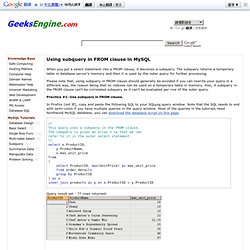
The subquery returns a temporary table in database server's memory and then it is used by the outer query for further processing. Please note that, using subquery in FROM clause should generally be avoided if you can rewrite your query in a different way, the reason being that no indexes can be used on a temporary table in memory. Also, A subquery in the FROM clause can't be correlated subquery as it can't be evaluated per row of the outer query. Data Binding in .NET / C# Windows Forms. Data binding provides a way for developers to create a read/write link between the controls on a form and the data in their application (their data model). Classically, data binding was used within applications to take advantage of data stored in databases. Windows Forms data binding allows you to access data from databases as well as data in other structures, such as arrays and collections.
Each Windows Form has at least one BindingContext object that manages the CurrencyManager objects for the form. Joins. Learn how to use JOINS (inner and outer) in Oracle with syntax, visual illustrations, and examples.
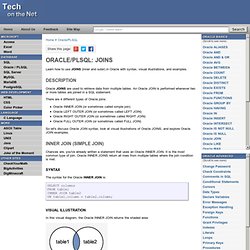
Description Oracle JOINS are used to retrieve data from multiple tables. An Oracle JOIN is performed whenever two or more tables are joined in a SQL statement. There are 4 different types of Oracle joins: Indexes and Index-Organized Tables. An index is an optional structure, associated with a table or table cluster, that can sometimes speed data access.
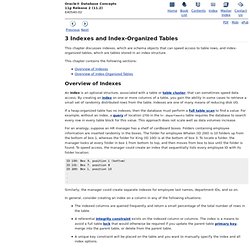
By creating an index on one or more columns of a table, you gain the ability in some cases to retrieve a small set of randomly distributed rows from the table. Indexes are one of many means of reducing disk I/O. If a heap-organized table has no indexes, then the database must perform a full table scan to find a value. For example, without an index, a query of location 2700 in the hr.departments table requires the database to search every row in every table block for this value. This approach does not scale well as data volumes increase. For an analogy, suppose an HR manager has a shelf of cardboard boxes. Similarly, the manager could create separate indexes for employee last names, department IDs, and so on. In general, consider creating an index on a column in any of the following situations: Index Characteristics. Using Indexes in Database Applications. This chapter explains how to use indexes in database applications.
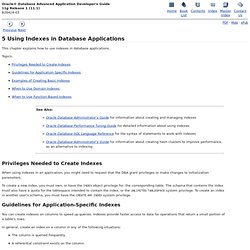
Privileges Needed to Create Indexes When using indexes in an application, you might need to request that the DBA grant privileges or make changes to initialization parameters. To create a new index, you must own, or have the INDEX object privilege for, the corresponding table. CREATE TYPE Statement. The CREATE TYPE statement specifies the name of the type and its attributes, methods, and other properties.
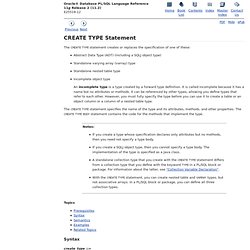
The CREATE TYPE BODY statement contains the code for the methods that implement the type. Semantics Re-creates the type if it exists, and recompiles it. Users who were granted privileges on the type before it was redefined can still access the type without being regranted the privileges. 5. Association Mapping. This chapter explains how associations between entities are mapped with Doctrine.

We start out with an explanation of the concept of owning and inverse sides which is important to understand when working with bidirectional associations. Please read these explanations carefully. 5.1. Owning Side and Inverse Side When mapping bidirectional associations it is important to understand the concept of the owning and inverse sides.
Oracle Approvals Management Implementation Guide. Browser version script Skip Headers Administration Overview The Administrator Dashboard is available only to users with the Application Administrator responsibility.
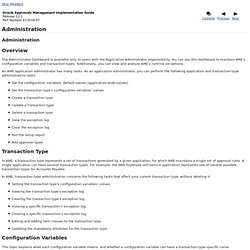
You can use this dashboard to maintain AME’s configuration variables and transaction types. QuickCode Lookup Types (Oracle Sales and Marketing Help) Code and Query Samples. This appendix contains samples that support emulation of the AUTONUMBER data type, CASCADE UPDATE referential integrity, and name mapping queries.

"Logout XSRF" - significant web app bug? IDataGridViewEditingControl Interface (System.Windows.Forms) Public interface class IDataGridViewEditingControl.
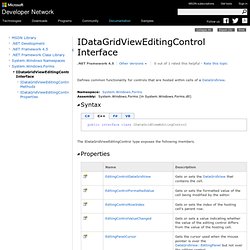
DataGridViewCell.OnLeave Method (System.Windows.Forms) Called when the focus moves from a cell. protected virtual void OnLeave( int rowIndex, bool throughMouseClick ) Parameters rowIndex.

DataGridViewTextBoxCell Class (System.Windows.Forms) The cell-related properties of the column are wrappers for the similarly-named properties of the template cell. Changing the property values of the template cell will affect only cells based on the template that are added after the change. Changing the cell-related property values of the column, however, will update the template cell and all other cells in the column, and refresh the column display if necessary.
How to: Host Controls in Windows Forms DataGridView Cells. C # DataGridView column to add DateTimePicker control - C# - C Program Develop. Tag: c #, Scroll is, class, 2010, objectCategory: C#Author: dfjlkasfeawfawfDate: 2012-03-12 A DateTimePicker control due the DataGridView comes ColumnType inside. To achieve an input column is too much trouble. The following ways to DataGridView DateTimePicker control. Insert, Update And Delete Records In Table With Datagridview Using C# - C# Tutorials. C# - Delete selected row from datagridview and update DB. Insert, Delete, Update in DataGridView with DataTable in C# - MindStick. PLSQL 101: Working with Cursors. By Steven Feuerstein Part 12 in a series of articles on understanding and using PL/SQL The central purpose of the Oracle PL/SQL language is to make it as easy and efficient as possible to query and change the contents of tables in a database. You must, of course, use the SQL language to access tables, and each time you do so, you use a cursor to get the job done.
A cursor is a pointer to a private SQL area that stores information about the processing of a SELECT or data manipulation language (DML) statement (INSERT, UPDATE, DELETE, or MERGE). Cursor management of DML statements is handled by Oracle Database, but PL/SQL offers several ways to define and manipulate cursors to execute SELECT statements. Oracle 11G R2 Hibernate. Sample PL/SQL Programs. PL/SQL Tutorial is an useful resource of pl/sql language for beginners and advanced developers. Database 11g: Advanced PL/SQL.
Data Mining Overview. Introduction. PL/SQL Basic Syntax. Sample PL/SQL Programs. Advanced PL/SQL Features. Oracle PL / SQL examples. Www6.uniovi.es/oracle/paulr_dw.pdf. Www6.uniovi.es/oracle/drp_vrad.pdf. Abstracts of some of the IOUW'95 presentations. Converted to html by Oracle User Group Finland (OUGF) Using Virtual Private Database to Implement Application Security Policies. Virtual Private Database (VPD) combines server-enforced fine-grained access control with a secure storage of application context values in the Oracle database server. VPD enables you to build applications that enforce row-level security policies at the object level. Database 11g: Advanced PL/SQL. Database 11g: Advanced PL/SQL.
Database 11g: Advanced PL/SQL. Database 11g: Advanced PL/SQL.